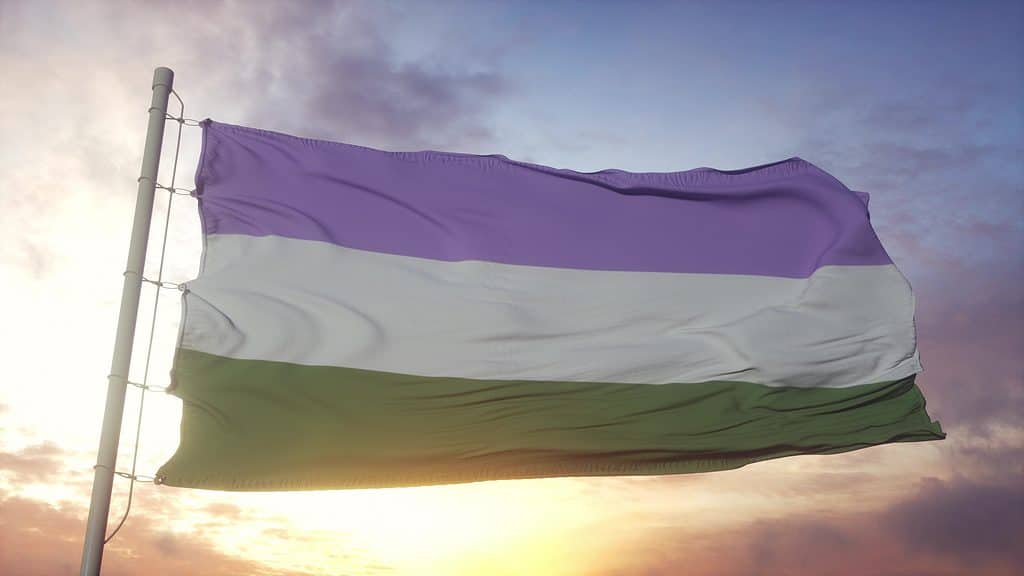There are a great number of flags that are neither national nor state flags. In certain circumstances, flags represent entire groups or movements. This is the case with the purple, white, and green flag. Even though the flag of the people it represents just has three colors and three horizontal stripes, this seeming lack of complexity is imbued with a tremendous deal of meaning to them. The community that this flag represents, as well as its design and meaning, will be discussed in further detail in the following article.
Purple, White, and Green Flag: What Could This Be?

The purple, white, and green flag is the Genderqueer flag.
©Larich/Shutterstock.com
The purple, white and green flag is the Genderqueer flag.
Although the rainbow flag has gained widespread recognition, it is not the only LGBQT+ flag. There are many additional flags that symbolize the wide range of gender identities that make up our wonderful world. While the rainbow flag is a symbol of pride for the LGBTQ community, many individuals also wish to fly a flag that represents their own identity.
The Genderqueer Pride Flag is one such banner, and you’ve probably seen it at pride events all across the globe. The flag of the genderqueer community is tricolored, with the colors purple, white, and green predominating the design.
The genderqueer community has utilized a broad array of flags to represent themselves. For example, a subgroup of the genderqueer community known as genderfluid individuals also has its very own flag. Those who also identify with the label “genderqueer” and consider themselves “agender” have their own flag as well.
Fun Fact: July 14th is International Nonbinary Day.
What Does Genderqueer Mean?
The term “genderqueer” is not as well-known among the general public as it is among members of the LGBTQ community. The term “genderqueer,” which is synonymous with “non-binary,” describes people whose gender identities fall outside of the gender binary and “hetero normative” yet are neither primarily masculine nor feminine. Genderqueer people’s gender expression may include elements of both masculinity and femininity or neither.
People who identify as genderqueer may also identify with more than one gender (as a bigender, trigender, or pangender person), with no gender at all (as an agender, gender-free, nongendered, genderless, or neutrois person), with a gender identity that shifts or changes over time (as a genderfluid person), or as a third gender or other-gendered person.
Persons who identify as genderqueer have a wide range of sexual orientations, much like transgender and cisgender people. The term “genderqueer” might signify different things to different people.
The Genderqueer Flag Design
Marilyn Roxie is a photographer and filmmaker who is credited with designing the flag that represents the genderqueer community. The design brings to mind flags that represent sexual minorities, such as those that represent gay, lesbian, bisexual, asexual, pansexual, and transgender groups. The stripes on these flags are often horizontal, and the colors each have a significant meaning in the context of the group that they represent.
The Symbolism of the Genderqueer Flag

The Genderqueer flag represents lesbian, gay, bisexual, transgender, and agnostic identities.
©Millenius/Shutterstock.com
The three colors of the Genderqueer flag—purple, white, and green—represent the lesbian, gay, bisexual, transgender, and agnostic communities and identities; the third gender; and gender neutrality, respectively. Furthermore, in the case of state flags in particular, the significance of the colors is usually sanctioned by official charters.
According to popular belief, the color purple (also known as lavender) stands for androgyny or generally queerness. Plus, it symbolizes the “queer” part of “genderqueer,” since lavender is a hue commonly associated with the LGBTQ+ and LBGTQ+ populations. As with the transgender pride flag, the color white indicates agender identification. People whose identities fall outside the binary are represented by the color green (a dark chartreuse green).
There are many more notions and variations of gender and sexuality that are tied into genderqueer orientations than can be stated here, and the three colors are not meant to represent that any of these identities are wholly independent or opposing to one another theoretically. The flag was designed to raise awareness for the gender-nonconforming community and allied identities.
In some cases, however, the symbolism is so firmly ingrained in local customs or so widely known among those who share a common ancestry with the native population that it is impossible to separate the two. Also, the Genderqueer flag’s colors can signify more than one thing.
Click here to learn about every single flag in the world!
Up Next:
- Green, White, and Green Flag: Nigeria Flag History, Meaning, and Symbolism
- Countries With Striped Flags
- White, Green, and Red Flag: Bulgaria Flag History, Meaning, and Symbolism
The photo featured at the top of this post is © Millenius/Shutterstock.com
Sources
- Flag Color Codes, Available here: https://www.flagcolorcodes.com/genderqueer
- Gender Queer ID, Available here: https://genderqueerid.com/about-flag
- Wikipedia, Available here: https://en.wikipedia.org/w/index.php?title=Genderqueer&oldid=874316981
Thank you for reading! Have some feedback for us? Contact the AZ Animals editorial team.






